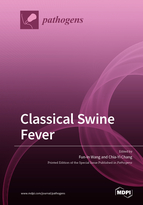Classical Swine Fever
A special issue of Pathogens (ISSN 2076-0817).
Deadline for manuscript submissions: closed (31 August 2020) | Viewed by 58848
Special Issue Editors
Interests: veterinary pathology; diagnostic pathology; pathogenesis of viral diseases and of swine diseases
Special Issues, Collections and Topics in MDPI journals
Interests: pestiviruses; virulence; pathogenesis; viral glycoprotein structure and function; epitope mapping
Special Issues, Collections and Topics in MDPI journals
Special Issue Information
Dear Colleagues,
Classical swine fever (CSF) is an ancient disease caused by the classical swine fever virus (CSFV), one member of the genus Pestivirus of the family Flaviviridae. Now after more than a century since its first recognition, our battle with this virus/disease is far from over. While some parts of the world have been CSF-free, reemergence from a previous CSF-free area is not unprecedented. In parts of the world where the disease is well-under-control, the virus/disease still lingers around, poses a potential threat, and colleagues there are striving for a CSF-free status. In those CSF-free areas, we would be interested to know what is their regular practice in order not to miss any reemerging cases in its earliest time, both clinically and by the laboratory practice. When striving for a CSF-free status or in reemergence, we would be interested to know the view of colleagues on vaccination and what measures they take in the endeavor. In those endemic areas, we would be interested to know how CSF is expressed clinically, how it is recognized and diagnosed, and how our colleagues handle it, particularly for the prevention. So we have much to learn and share in the veterinary community.
Been a single virus with a single serotype, the CSFV is constantly tangled with the immunity and pressure that the hosts and the environment imposed on them. Antigenic variations are constantly being selected. Cross reactivity with other related viruses and vaccine viruses needs to be differentiated. In the meantime, newer generation DIVA vaccines are being developed. It would be interesting to know how the virus establish itself in the animal body, how the virus signals itself to gain control or co-exist within the cells, and what are the consequences in different types of cells and cellular organelles. Over the years, CSFV may disguise and express itself with other common swine pathogens clinically, for example, those also causing fever, hemorrhages, lymphoid depletion, abortion or stillbirth etc. Under various circumstances, for example, the use of vaccines or the presence of partial or non-neutralizing immunity, they may express themselves in unusual forms that are different from those the textbook tells of, and it often requires the laboratory practices to confirm its expression.
Nowadays in the wake of other currently prevailing swine diseases, the CSF/CSFV seem raises little attention on the veterinary forum. In spite of this, veterinarians and scientists in all corners of the world are continually working, silently and diligently, trying to gain grounds on this battle. We would like to take this opportunity, that the MDPI Inc. creates for us, to welcome colleagues to share their experience and results, whether clinical or basic, whether low tech or high tech.
Prof. Dr. Fun-In Wang
Dr. Chia-Yi Chang
Guest Editors
Manuscript Submission Information
Manuscripts should be submitted online at www.mdpi.com by registering and logging in to this website. Once you are registered, click here to go to the submission form. Manuscripts can be submitted until the deadline. All submissions that pass pre-check are peer-reviewed. Accepted papers will be published continuously in the journal (as soon as accepted) and will be listed together on the special issue website. Research articles, review articles as well as short communications are invited. For planned papers, a title and short abstract (about 100 words) can be sent to the Editorial Office for announcement on this website.
Submitted manuscripts should not have been published previously, nor be under consideration for publication elsewhere (except conference proceedings papers). All manuscripts are thoroughly refereed through a single-blind peer-review process. A guide for authors and other relevant information for submission of manuscripts is available on the Instructions for Authors page. Pathogens is an international peer-reviewed open access monthly journal published by MDPI.
Please visit the Instructions for Authors page before submitting a manuscript. The Article Processing Charge (APC) for publication in this open access journal is 2700 CHF (Swiss Francs). Submitted papers should be well formatted and use good English. Authors may use MDPI's English editing service prior to publication or during author revisions.
Keywords
- epidemiology
- reemergence
- endemic
- wild boar
- pathogenesis
- atypical form
- chronic form
- late-onset form
- congenital form
- virulence
- antigen
- cross-reaction
- vaccine
- cross-protection
- diagnosis
- detection
- DIVA
- phylogenetics
- prevention
- control








